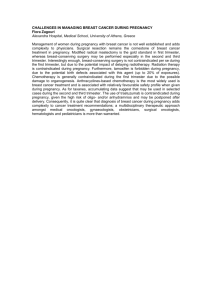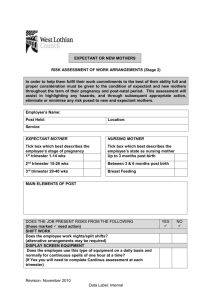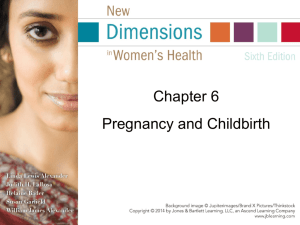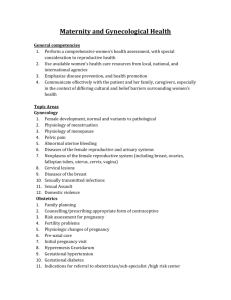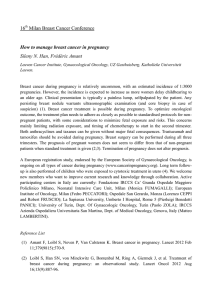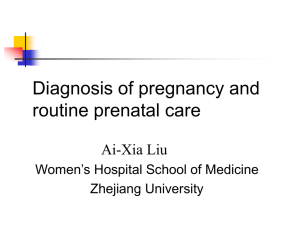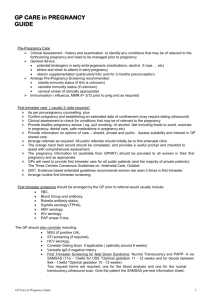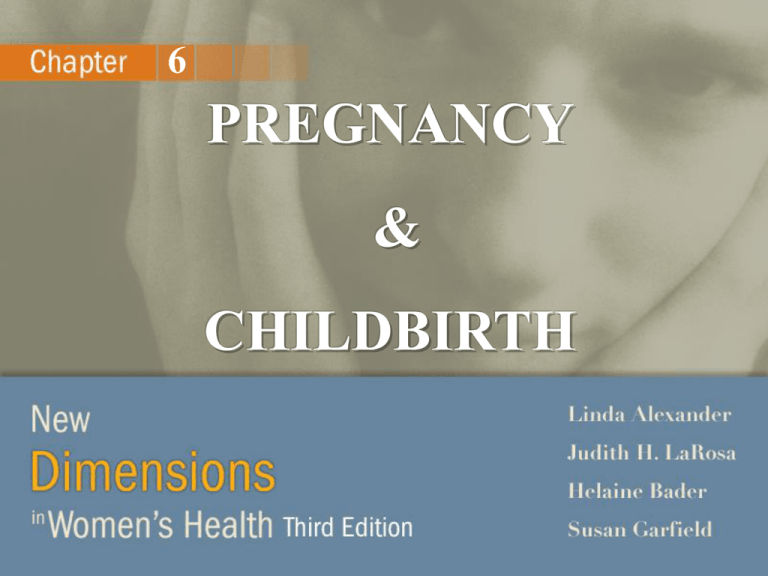
6
PREGNANCY
&
CHILDBIRTH
6
“To everything there is a
season, and a time to
every purpose under
heaven.”
- Ecclesiastes -
6
HISTORICAL DIMENSIONS
18th CENTURY
France – midwives
England – development of instruments
America – physicians
“wet nurse” vs. “dry nurse”
19th CENTURY
Interventions – medications, anesthesia,
birthing instruments
Hospital births
6
20th CENTURY
technology, medicalization, hospitalization
Controlling fertility
Natural-birth relaxation techniques
1970s: Benefits of breastfeeding resurfaced
Childbirth = joy and knowledge vs. fear and ignorance
6
PREGNANCY
CONCEPTION
Fertilization = Sperm Cell + Egg Cell = Zygote
Sperm Cell: 50 million produced/day
Egg Cell: 1 egg released/month
Dizygotic Twins = Fraternal Twins
Monozygotic Twins = Identical Twins
6
Selected Sex Chromosome
Abnormalities
Normal
(XY)
Turner Syndrome (Monosomy X, XO)
Triple X (XXX)
Klinefelter Syndrome (Trisomy XXY)
XXY Male
6
CONFIRMING PREGNANCY
Early Signs of Pregnancy
Symptoms often occur in first 6 weeks
Missed period(s)
Breast swelling/tenderness
Fatigue
Queasiness or nausea/vomiting
Elevated body temperature
Mood swings
Frequent urination
6
HORMONAL CHANGES
A/ Fertilization:
1. Follicle-Stimulating Hormone (FSH) and
Luteinizing Hormone (LH) produced by
anterior pituitary gland is surpressed
2. Pregnancy-specific hormones increase (hCG
and HPL)
B/ Implantation:
1. Embryo cells secrete hCG
2. Corpus Luteum stimulated and secrete
estrogen and progesterone
6
C/ After 3 Months:
1. hCG levels decrease
2. Placenta produces estrogen and progesterone
3. Fetal adrenal glands produce precursor
hormone to be converted into estrogen
4. Estrogen = regulate progesterone, fetal
maturation (lungs, liver, organs mature),
prepare breasts for lactation
5. Progesterone = suppresses uterine
contractions, stimulates alveoli of breasts
6. HPL = physical changes in maternal system to
accommodate fetus
6
PHYSICAL & EMOTIONAL
SYMPTOMS
1st Trimester:
Enlarged and tender breasts
Morning sickness
Extreme fatigue
Decreased interest in sex
Moodiness and irritability
Skin changes
Darkening of nipple and areola
6
2st Trimester:
Morning sickness subsides
Gastrointestinal problems
Gain majority of weight (12-14 lbs)
Breathing problems
Backache
Leg cramps and numbness/tingling of hands
Swollen and bleeding gums
Braxton-Hicks contractions
Striae gravidarum
Chloasma
Linea nigra
6
3rd Trimester:
Heartburn
Constipation
Leg cramps
Backache
Breathlessness
Braxton-Hicks contractions
Leukorrhea
Colostrum
Hemorrhoids
Pelvic and buttock discomfort
6
A Pregnant Woman’s Body Changes:
6
FETAL DEVELOPMENT
6
PRENATAL CARE
NUTRITION
Consume additional 100 calories/day during 1st
trimester
Consume additional 300 calories/day 2nd-3rd trimester
Folic acid
Calcium
Iron
Fluid intake
Weight Gain: Average 25-35 lbs. total
6
EXERCISE
Benefits:
Feel better throughout
trimesters
Shorter labor
Quicker recovery
Forms:
Swimming
Walking
Low-impact aerobics
Kegel exercises
6
AVOIDING TOXIC SUBSTANCES
Cigarette Smoking:
12.2% of women smoke during pregnancy
Native Americans (20%)
Hawaiian Americans (14.4%)
White Americans (13.2%)
Complications
birth-weight
Infertility
Ectopic pregnancies
Placental irregularities and intrauterine growth retardation
Sudden Infant Death Syndrome (SIDS)
6
Fetal Alcohol Syndrome:
12.8% of all pregnant women drank alcohol
Complications…
Growth retardation
Facial malformations
Central nervous system dysfunction
Mental retardation
6
Environmental Risk:
Pregnant women should avoid the following as
precautionary measures to protect herself and baby…
Pollutants
Toxic wastes
Heavy metals
Pesticides
Gases
Radiation treatment
Diagnostic X-rays
Heat exposure
6
Prenatal Testing:
Ultrasound: (6th – 12th weeks)
Maternal Serum Alpha-Fetoprotein Screening (MSAFP):
(13th – 20th weeks)
Chorionic Villus Sampling (CVS): (1st Trimester)
Amniocentesis: (15th – 18th weeks)
Rh Incompatibility: (Injection of Rh immune globulin after
delivery, during pregnancy, after a miscarriage, after
amniocentesis)
6
Chorionic Villus Sampling Procedure
6
Amniocentesis Procedure
6
COMPLICATIONS
MISCARRIAGE
16% of all pregnancies
Pregnancy ends before 20th week of gestation
Bleeding and cramping
Cervix dilates and embryo is released
ECTOPIC PREGNANCY
1 in every 40-100 pregnancies
Occurs 7th-8th week of pregnancy
Fertilized egg grows outside uterine cavity
Abdominal pain, spotting, ruptured fallopian tube, PID
6
PREMATURE LABOR
10% of all babies are born early
If starts before 37th week
Normal labor lasts for 38 - 42 weeks
Warning signs…
Vaginal bleeding
Abdominal pain
Persistent nausea, vomiting
Unusual thirst
Fever/chills
Facial, feet, or finger swelling
Vaginal fluid leaks
Severe continuous headaches
6
GENETIC DISORDERS &
CONGENITAL ABNORMALITIES
Cystic Fibrosis
Down Syndrome
Sickle Cell Anemia
Phenylketonuria (PKU)
Tay-Sachs Disease
Spina Bifida
6
INFECTIONS
Gonorrhea, Chlamydia, Syphilis Miscarriages
Bacterial Vaginosis (BV) birth weight, risk
HIV
Perinatal Transmission of AIDS AZT
Cytomegalovirus (CMV) birth size, brain
damage, developmental problems,
enlarged liver, hearing and vision
impairment, malformations
Group B Streptococcus (GBS) sepsis, pneumonia,
meningitis, long-term disabilities, death
6
CHILDBIRTH
PREPARATION
6
LABOR & DELIVERY
3 Distinctive Signs of Labor:
1. Uterine Contractions = every 5 minutes
2. Rupture of the Membranes = leak of fluids
3. Body Show = passage of mucous plug of cervix
= cervix dilates
Other Signs:
Diarrhea
Backache
Braxton-Hicks contractions
6
3 STAGES OF LABOR
6
DILATION THROUGH STAGES OF LABOR
6
PAIN RELIEF IN CHILDBIRTH
Tranquilizers and Analgesics
Anesthetics
Epidural = injected through catheter beside spinal
cord
Spinal = injected directly into spinal canal
Pudendal = injected into area around vagina and
perineum
6
CESAREAN DELIVERY
Surgical incisions made in both the wall of the
mother’s abdomen and her uterus
Reasons:
Cephalopelvic Disproportion
Multiple Births
Placenta Previa
Fetal Distress
Abruptio Placentae
Prolapsed Cord
6
BREASTFEEDING
THE FEMALE BREAST
6
BENEFITS OF BREASTFEEDING
For Baby:
Breast milk is highly nutritious
Breast milk contains enzymes to aid in infant digestion
Breast milk contains antibodies to protect against infection
infant episodes of diarrhea
infant cases of upper respiratory, ear and urinary infections
protect against type 1 diabetes, Crohn’s disease, SIDS, chronic
digestive disease, childhood cancers
For Mom:
Uterus returns to normal size more quickly
Return to pre-pregnancy weight more quickly
risk of ovarian and breast cancer, osteoporosis
6
COMPLICATIONS OF BREASTFEEDING
Do not breastfeed if mother…
HIV infected
Untreated active TB
User of alcohol, tobacco, or other drugs
Undergoing cancer therapy/radiation treatment
Mothers may experience difficulties if…
Inverted, flat, raw, or cracked nipples
Severely swollen breasts
Problems with infant latching-on
Pain during latching-on
Mastitis
6
INFERTILITY
CAUSES
Female Infertility = 25% to 35% of couples
Male Infertility = 25% to 35% of couples
Azoospermia, Oligospermia
DIAGNOSIS
Ovulation Test and Cervical Mucus Test
Postcoital Test
Blood Test
Hysterosalpingogram, Laparoscopic Surgery
6
TREATMENT
Improve quality of cervical mucus = Estrogen
Stimulate ovulation = Clomid, GnRH
Assisted Reproductive Technologies (ART)
In Vitro Fertilization (IVF)
Gamete Intrafallopian Transfer (GIFT)
Zygote Intrafallopian Transfer (ZIFT)
Intracytoplasmic Sperm Injection (ICSI)
Egg Donation
Embryo Transfer
Host Uterus
Surrogacy
6
EMOTIONAL EFFECTS OF INFERTILITY
Anger and resentment towards partners
Guilt and blame towards oneself
Depression and frustration
Miscommunication
Confusion
Grief
Despair
Loss of control
6
EPIDEMIOLOGY
LIVE BIRTH RATES PER 1,000 WOMEN
IN SPECIFIC GROUPS, U.S.
6
BREASTFEEDING
In 1993 = 58.1% mothers breastfed
In 1998 = 64% mothers breastfed
Whites = 68%, Hispanics = 66%, Blacks = 45%
INFERTILITY
15% of U.S. women of childbearing age sought
treatment for infertility
In 2000 = 35,025 babies were born using ART
6
INFORMED
DECISION MAKING
CHOICES OF ART PROCEDURES IN U.S., 2000

